Lecture notes written by Albert Jacka VC
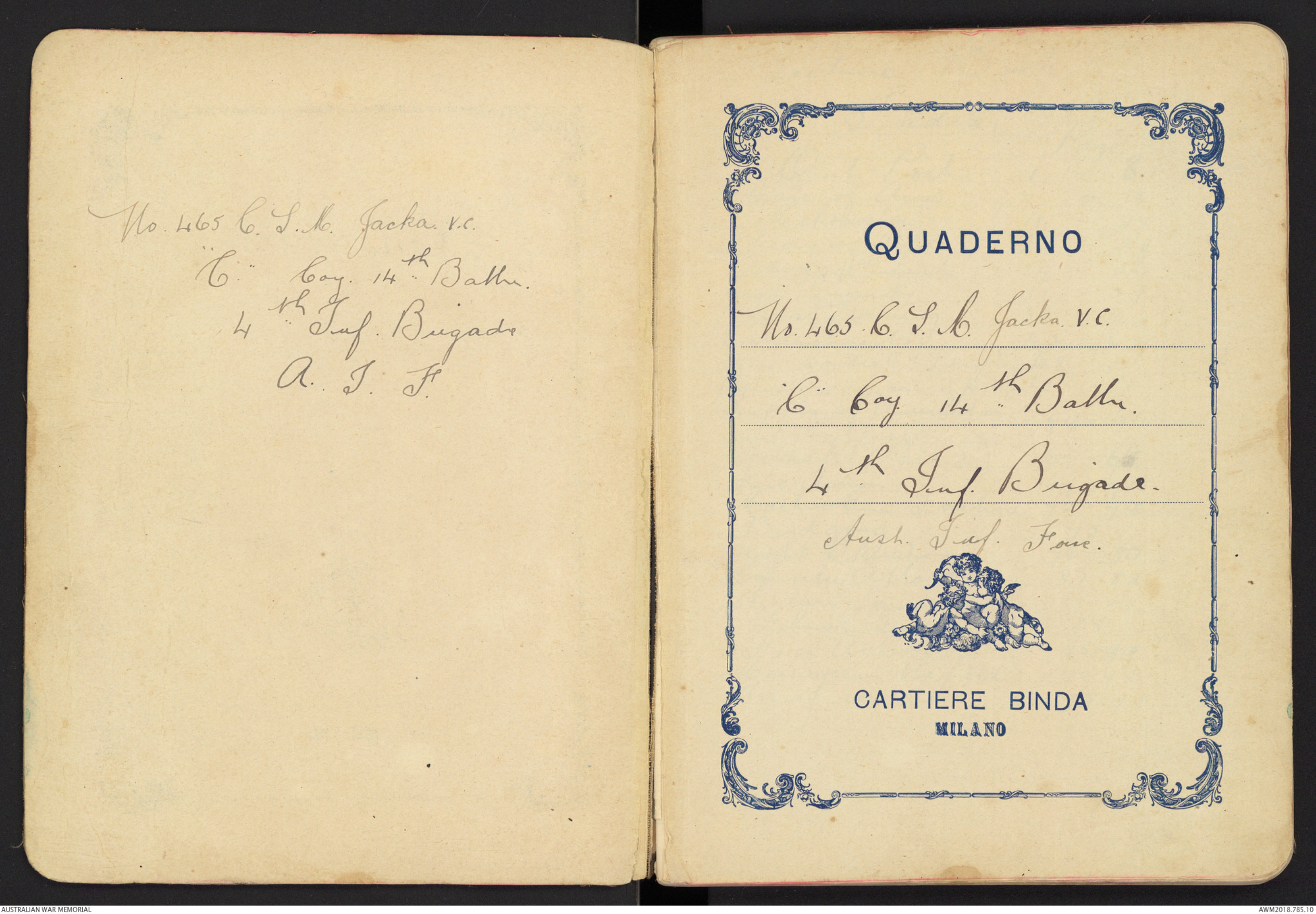
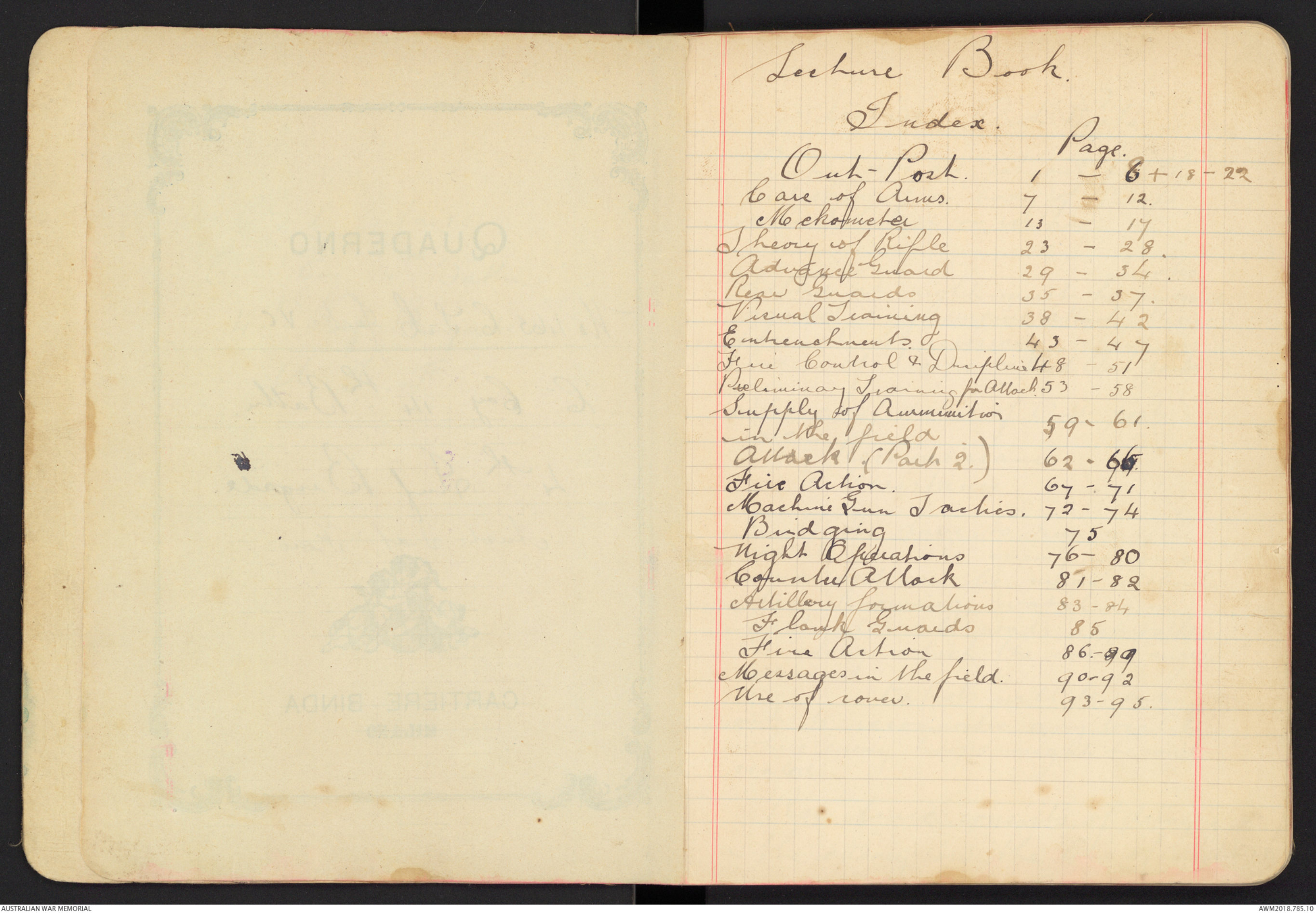

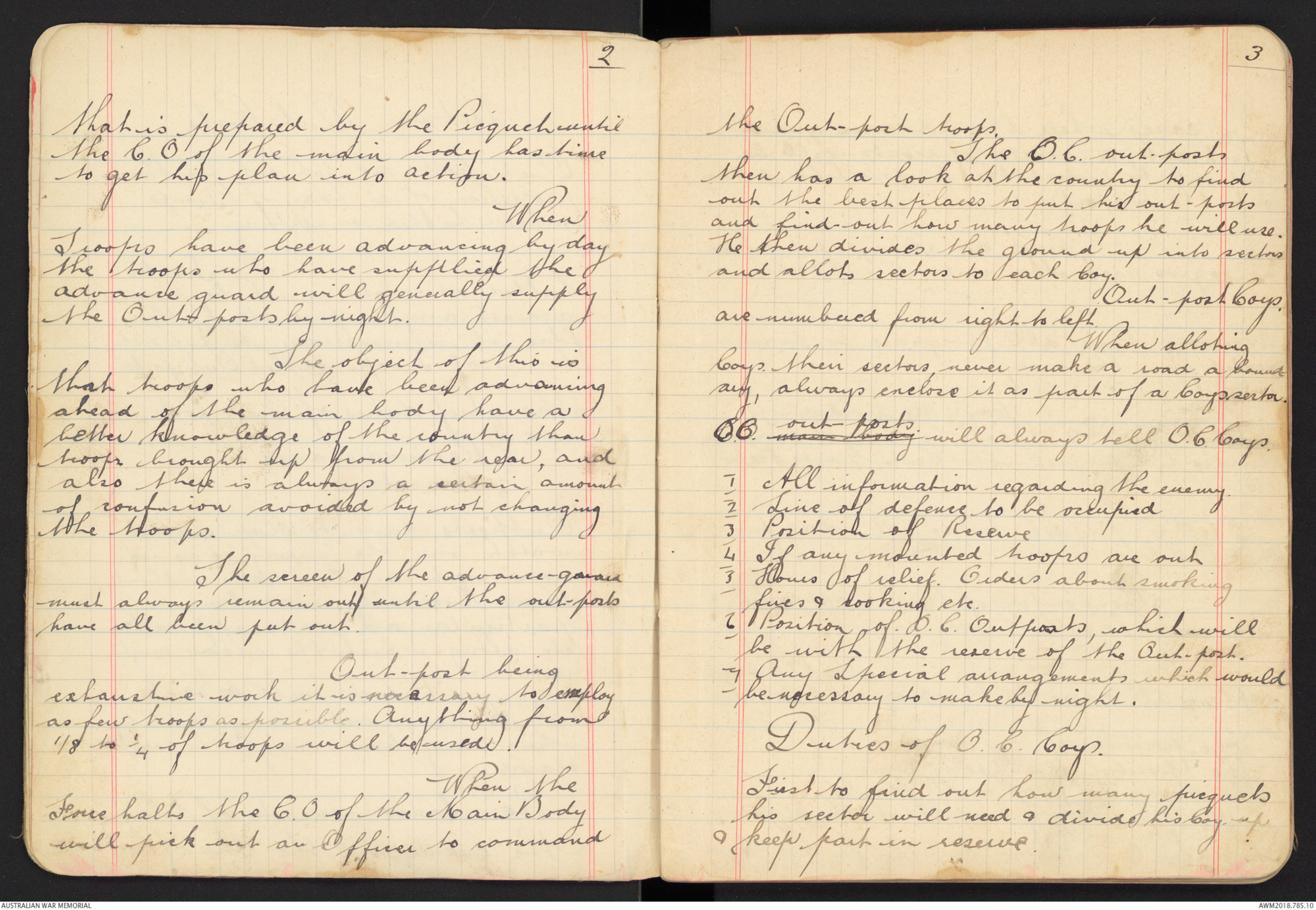
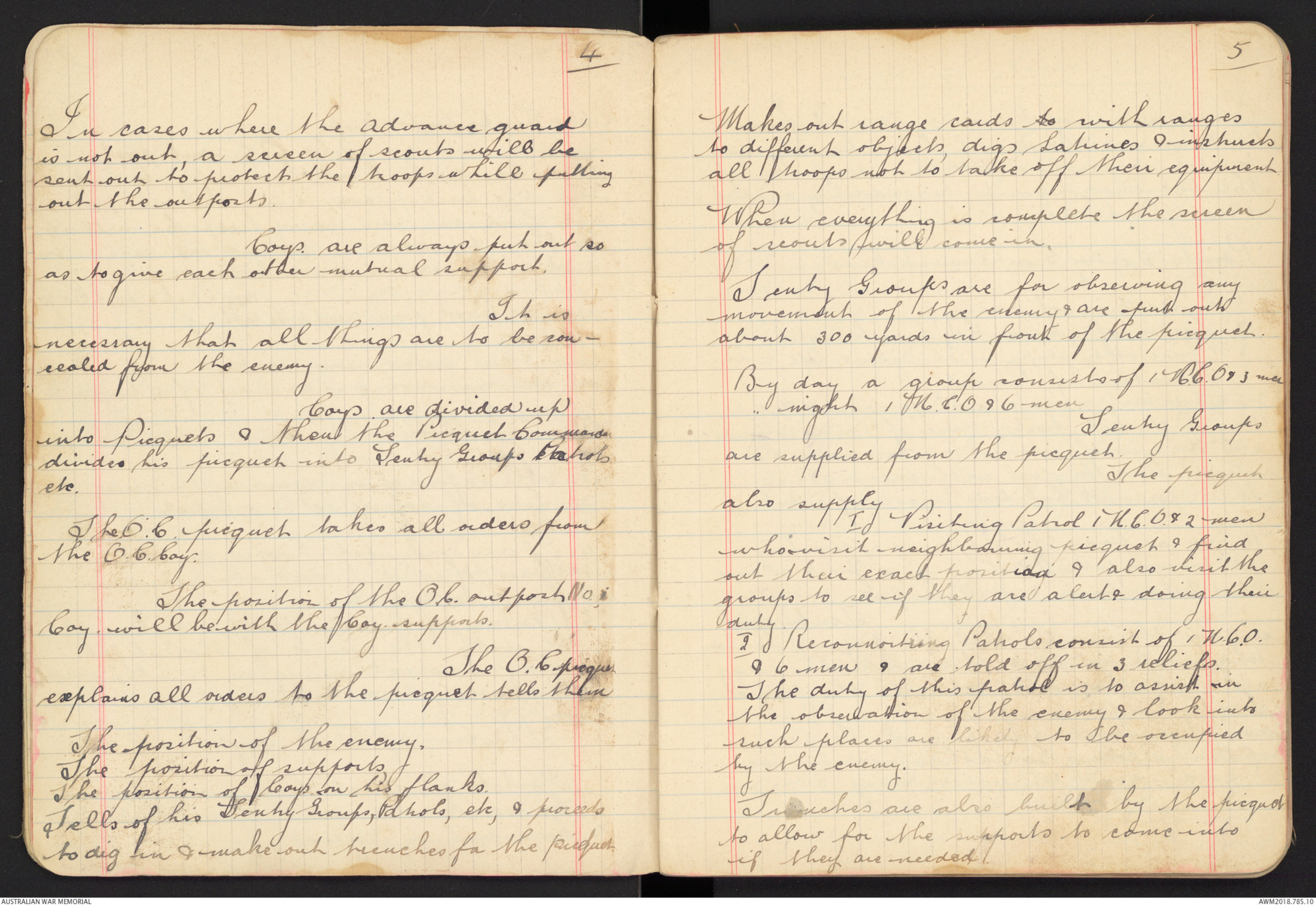
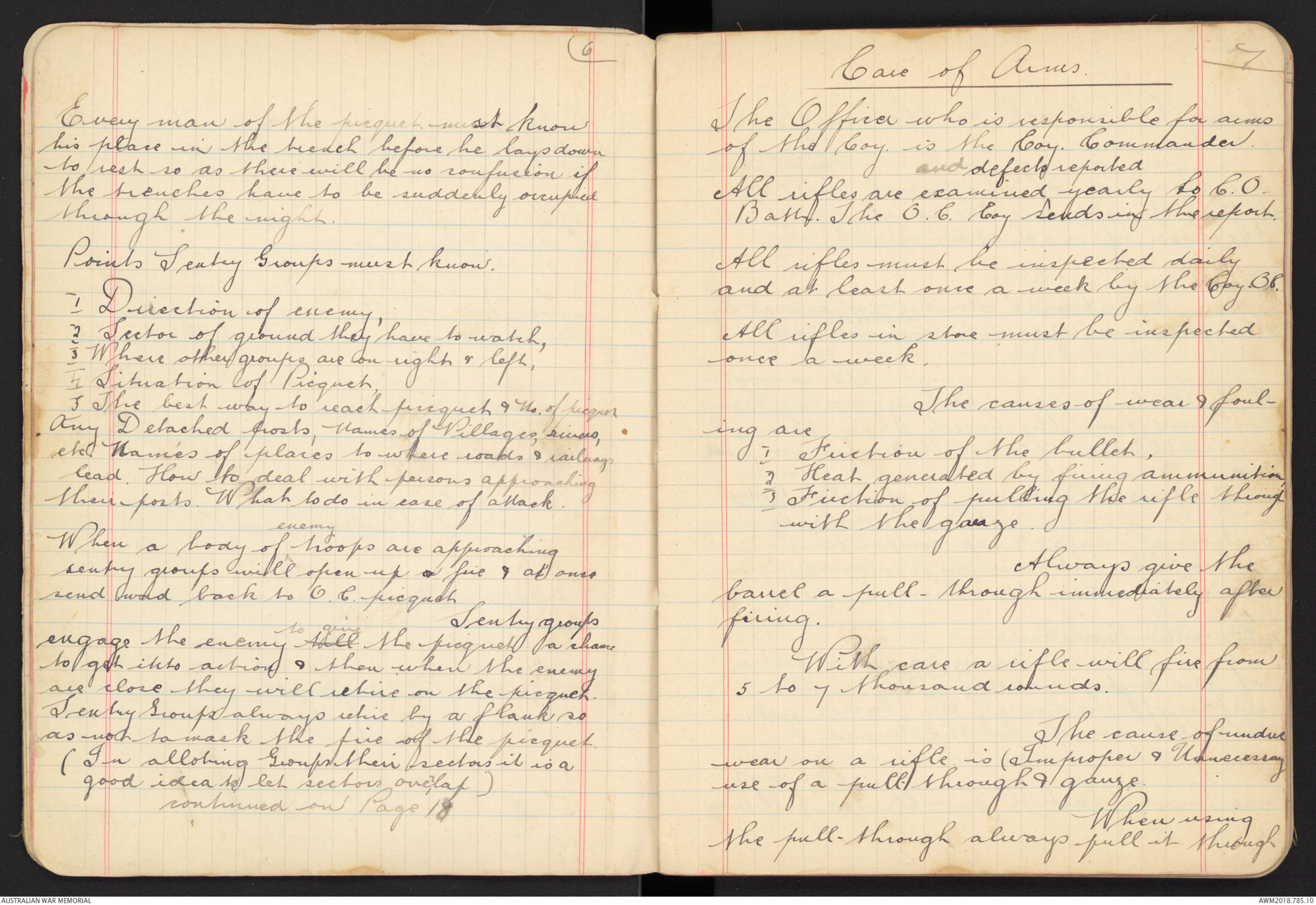
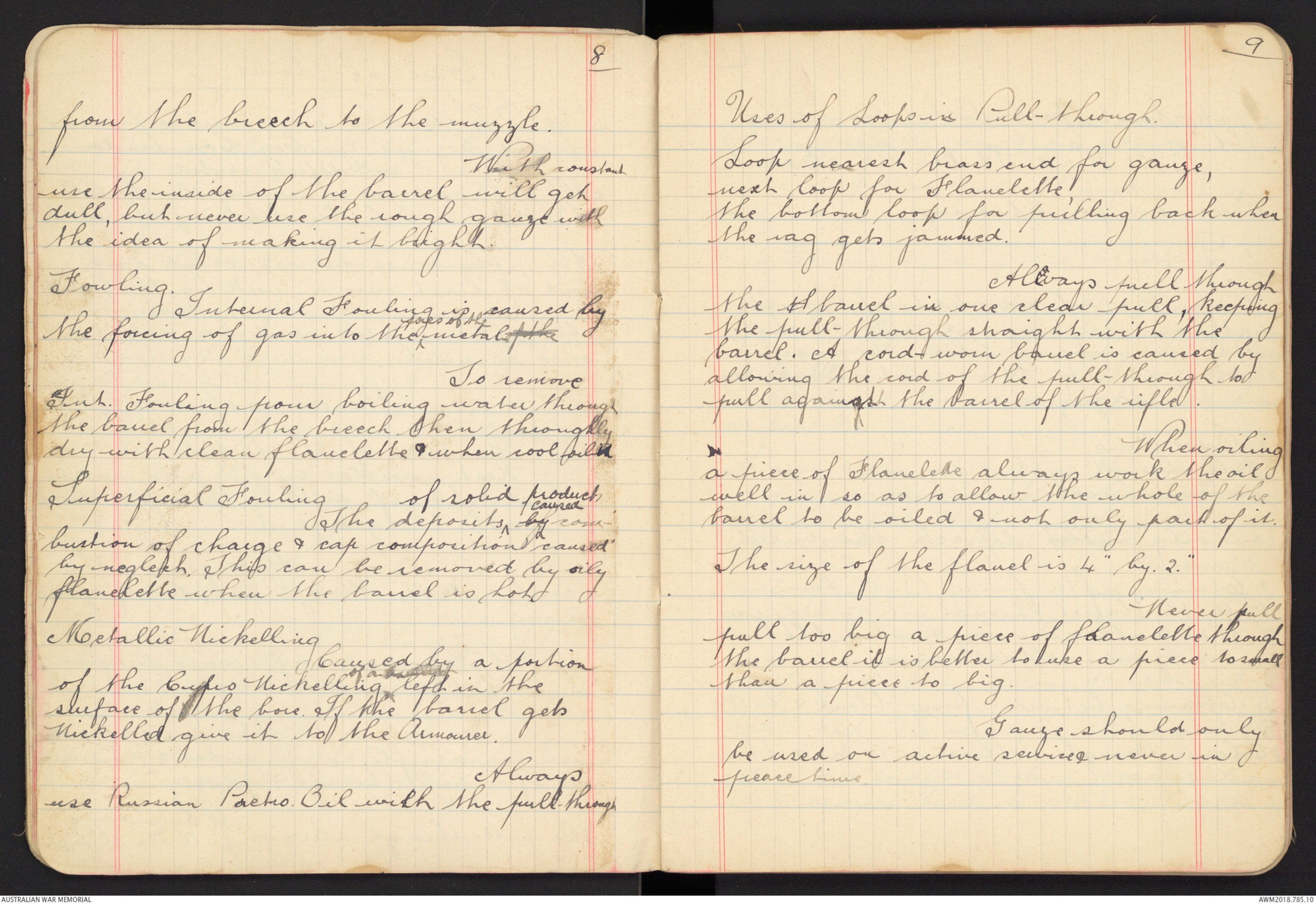
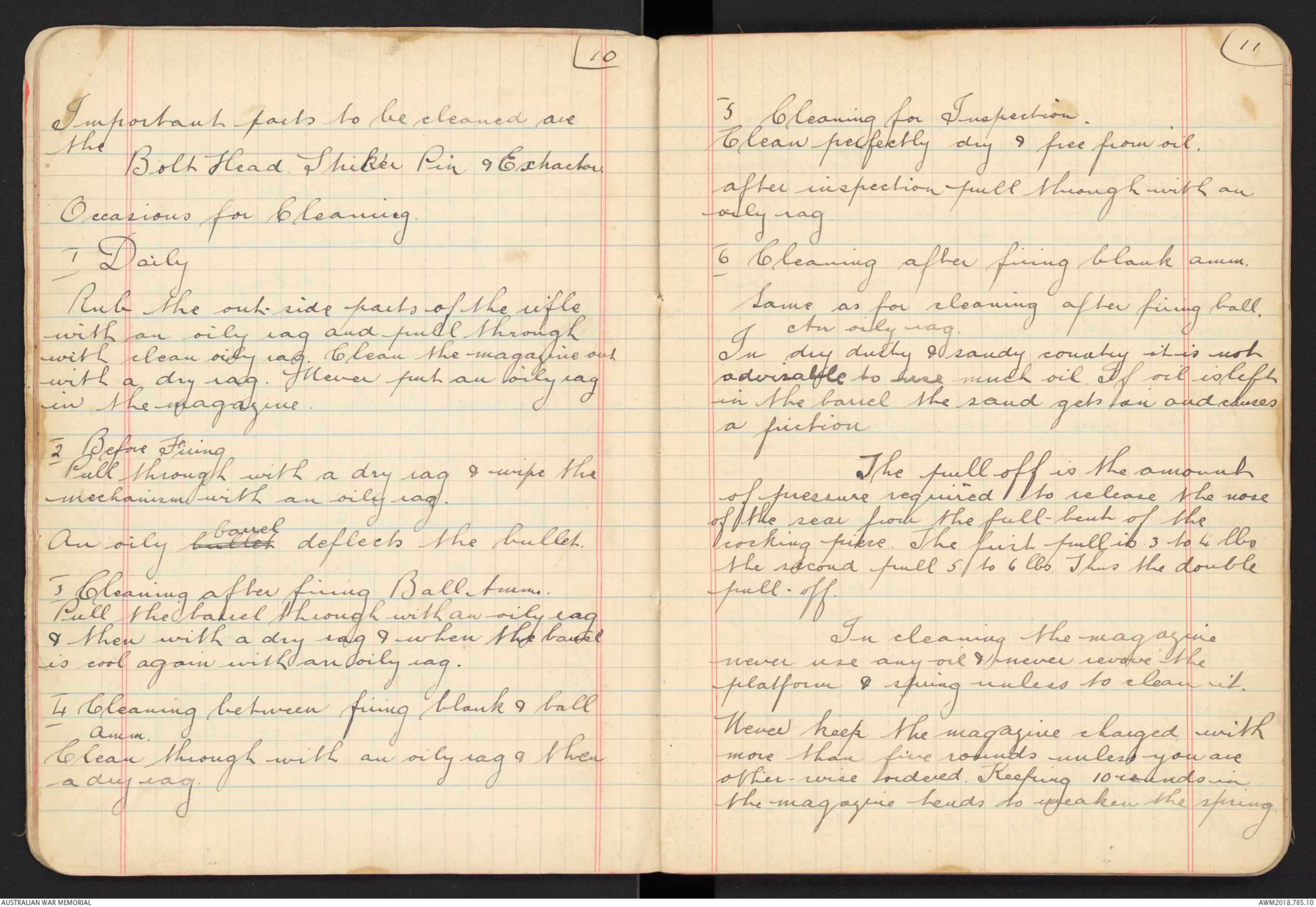
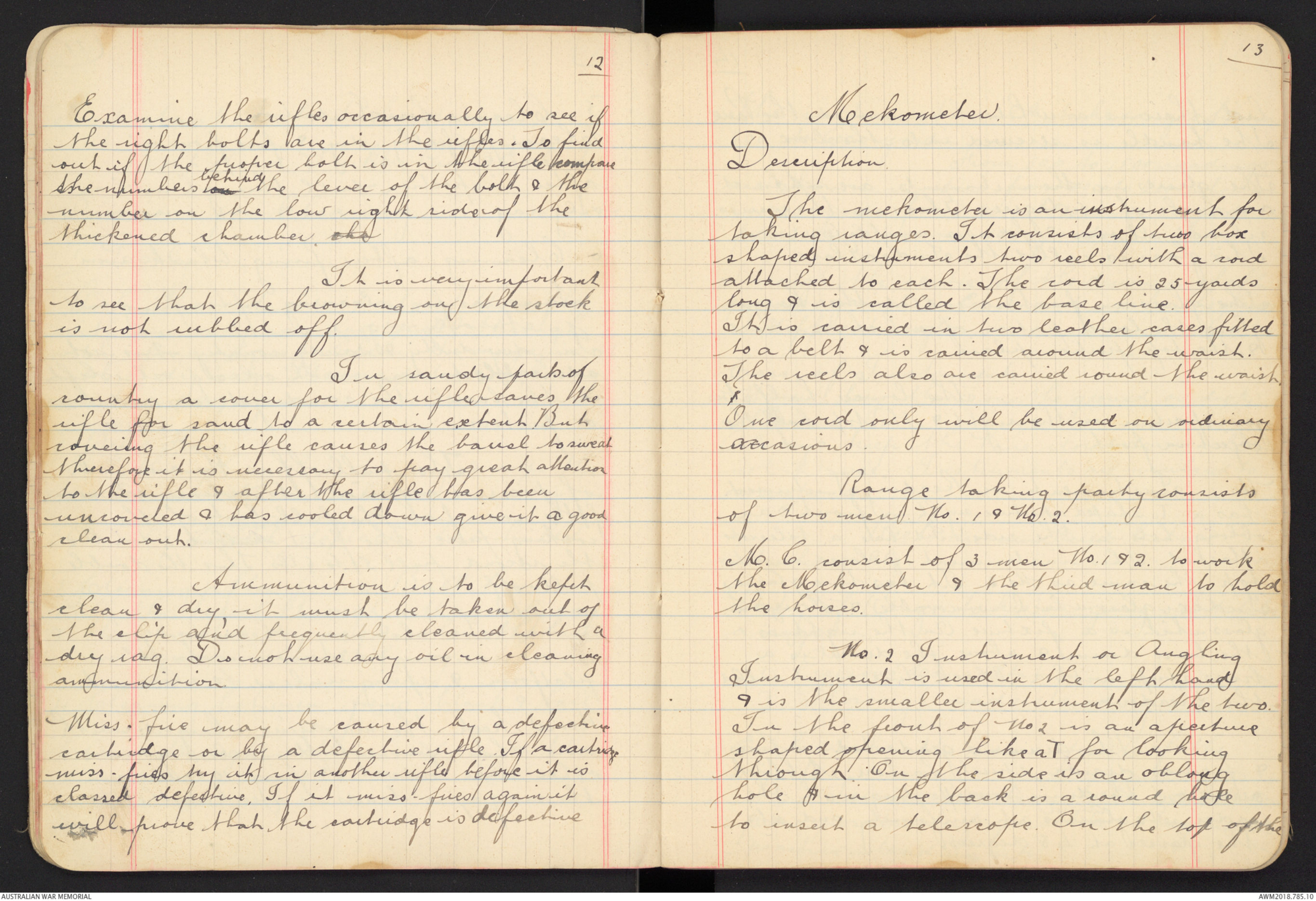
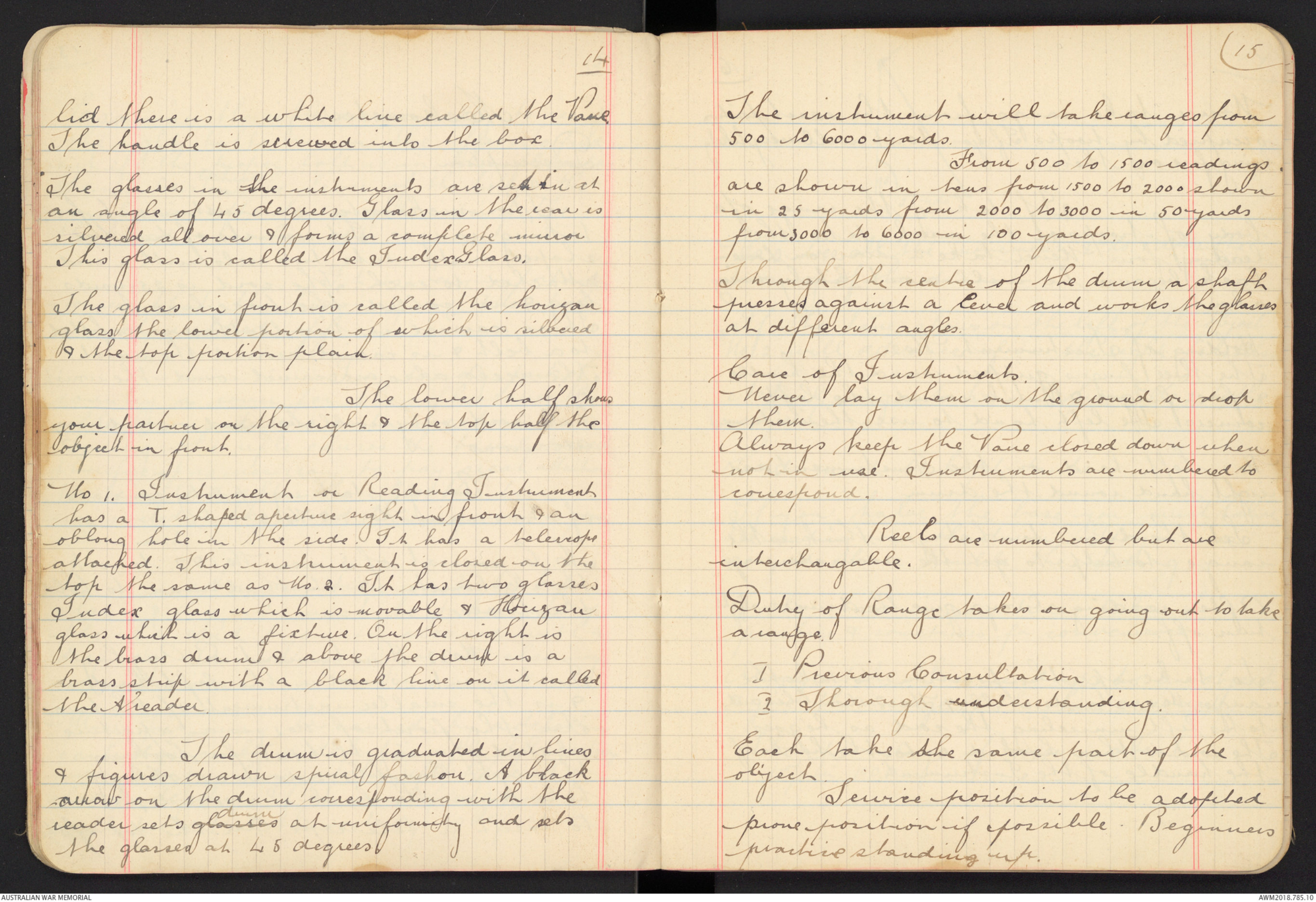
No. 465 C. S. M. Jacka V.C.
"C" Coy. 14th Battn
4th Inf. Brigade
A.I.F.
QUADERNO
No. 465. C. S. M. Jacka V.C.
"C" Coy 14th Battn.
4th Inf. Brigade
Aust. Inf. Force.
CARTIERE BINDA
MILANO
Lecture Book.
Index Page.
Out-Post. 1 - 8 + 18 - 22
Care of Arms. 7 - 12.
Mekometer 13 - 17
Theory of Rifle 23 - 28.
Advance Guard 29 - 34.
Rear Guards 35 - 37.
Virtual Training 38 - 42
Entrenchments. 43 - 47
Fire Control & Discipline 48 - 51
Preliminary Training for Attack 53 - 58
Supply of Ammunition
in the field 59 - 61
Attack (Part 2.) 62 - 66
Fire Action. 67 - 71
Machine Gun Tactics. 72 - 74
Bridging 75
Night Operations 76 - 80
Counter Attack 81 - 82
Artillery Formations 83 - 84
Flank Guards 85
Fire Action 86 - 89
Messages in the field. 90 - 92
Use of cover. 93 - 95.
1
Lecture. Out-posts.
Out-posts are put out for the
protection of a body of Troops
when halted or resting.
Troops
halted at night must be protected
against any surprise attack, therefore
it is necessary to put out
bodies of Troops called "Out-posts."
The chief duties of Out-posts
are
1 Reconnaissance
2 Resistance
Outposts have to keep a close
watch on the enemy so as no
move-ment can be made without
them knowing, watching in
particular all roads, approaches
etc. along which the enemy might
advance
Patrols will be sent
out to reconnoitre any locality
where enemy troops might be concealed.
Resistance consists of delaying
the enemy on the line of resistance
2
that is prepared by the Picquet until
the C.O. of the main body has time
to get his plan into action.
When
Troops have been advancing by day
the troops who have supplied the I
advance guard will generally supply
the Out-posts by night.
The object of this is
that troops who have been advancing
ahead of the main body have a
better knowledge of the country than
troops brought up from the rear, and
also there is always a certain amount
of confusion avoided by not changing
the troops.
The screen of the advance-guard
must always remain out until the out-posts
have all been put out.
Out-post being
exhaustive work it is necessary to employ
as few troops as possible. Anything from
1/8 to ¼ of troops will be used.
When the
Force halts the C.O of the Main Body
will pick out an Officer to command
3
the Out- post troops
The O.C. out-posts
then has a look at the country to find
out the best places to put his out-posts
and find-out how many troops he will use.
He then divides the ground up into sectors
and allots sectors to each Coy.
Out-post Coys.
are numbered from right to left.
When alloting
Coys. their sectors never make a road a boundary,
always enclose it as part of a Coys sector.
O.C. main body out-posts. will always tell O.C. Coys.
1 All information regarding the enemy
2 Line of defence to be occupied
3 Position of Reserve
4 If any mounted troops are out
5 Hours of relief. Orders about smoking,
fires & looking etc.
6 Position of. O.C. Outposts, which will
be with the reserve of the Out-post.
7 Any special arrangements which would
be necessary to make by night.
Duties of O.C. Coys.
First to find out how many picquets
his sector will need & divide his Coy. up
keep part in reserve.
4
In cases where the advance guard
is not out, a screen of scouts will be
sent out to protect the troops while putting
out the outposts.
Coys. are always put out so
as to give each other mutual support.
It is
necessary that all things are to be concealed
from the enemy.
Coys. are divided up
into Picquets & then the Picquet Commander
divides his picquet into Sentry Groups, Patrols
etc.
The O.C piquets takes all orders from
the O.C. Coy.
The position of the O.C. outpost [*No i*]
Coy will be with the Coy. supports.
The O.C. piquets
explains all orders to the picquet tells them
The position of the enemy.
The position of supports
The position of Coys on his flanks.
& tells of his Sentry Groups, Patrols, etc, & proceeds
to dig in & make out trenches for the picquet.
5
Makes out range cards to with ranges
to different objects, digs Latrines & instructs
all troops not to take off their equipment.
When everything is complete the screen
of scouts will come in.
Sentry Groups are for observing any
movement of the enemy & are put out
about 300 yards in front of the picquet.
By day a group consists of 1 N.C.O & 3 men
" night 1 N.C.O & 6 men
Sentry Groups
are supplied from the picquets.
The picquets
also supply
1 Visiting Patrol Patrol 1 NC.O. & 2 men
who visit neighbouing picquets & find
out their exact position & also visit the
groups to see if they are alert & doing their
duty.
2 Reconnoitring Patrols consist of 1 N.C.O.
& 6 men & are told off in 3 reliefs.
The duty of this pratrol is to assist in
the observation of the enemy & look into
such places are likely to be occupied
by the evemy.
Trenches are also built by the picquet
to allow for the supports to come into
if they are needed.
6
Every man of the picquet must know
his place in the trench before he lays down
to rest so as there will be no confusion if
the trenches have to be suddenly occupied
through the night.
Points Sentry Groups must know.
1 Direction of enemy,
2 Sector of ground they have to watch,
3 Where other groups are on right & left,
4 Situation of Picquets,
5 The best way to reach picquets & No. of picquets
Any Detached posts, Names of Villages, rivers,
etc. Names of places to where roads & railways
lead. How to deal with persons approaching
their posts. What to do in case of attack.
When a body of ^enemy troops are approaching
sentry groups will open up & fire & at once
send word back to O.C. picquets
Sentry groups
engage the enemy till to give the picquet a chance
to get into action & then when the enemy
are close they will retire on the picquet.
Sentry Groups always retire by a flank so
as not to mask the fire of the picquet.
(In alloting Groups their sectors it is a
good idea to let sectors overlap)
continued on Page 18
7
Care of Arms.
The Officer who is responsible for arms
of the Coy is the Coy. Commander.
All rifles are examined ^and defects reported yearly to C.O
Batn. The O.C. Coy sends in this report.
All rifles must be inspected daily
and at least once a week by the Coy O.C.
All rifles in store must be inspected
once a week.
The causes of wear & fouling
are
1 Friction of the bullets
2 Heat generated by firing ammunition
3 Friction of pulling the rifle through
with the gauze
Always give the
barrel a pull-through immediately after
firing.
With care a rifle will fire from
5 to 7 thousand rounds.
The cause of undue
wear on a rifle is (Improper & Unnecessary)
use of a pull-through & gauze
When using
the pull-through always pull it through
8
from the breech to the muzzle.
With constant
use the inside of the barrel will get
dull, but never use the rough gauze with
the idea of making it bright.
Fowling.
Internal Fouling is caused by
the forcing of gas into the ^pores of the metal of the
To remove
Int. Fouling pour boiling water through
the barrel from the breech then throughly
dry with clean flanelette & when cool oiled.
Superficial Fouling
The deposits ^of solid products caused by combustion
of charge & cap composition caused
by neglect. This can be removed by oily
flanelette when the barrel is hot.
Metallic Nickelling
Caused by a portion
of the Cupio Nickelling ^of a [[barrel?]] left in the
surface of the bore. If the barrel gets
Nickelled give it to the Armourer.
Always
use Russian Paetro Oil with the pull-through
9
Uses of Loops in Pull-through.
Loop nearest brass end for gauze,
next loop for Flanelette,
the bottom loop for puilling back when
the rag gets jammed.
Always pull through
the sI barrel in one clear pull, keeping
the pull-through straight with the
barrel. A cord-worn barrel is caused by
allowing the cord of the pull-through to
pull against the barrel of the rifle.
When oiling
a piece of Flanelette always work the oil
well in so as to allow the whole of the
barrel to be oiled & not only part of it.
The size of the flanel is 4" by. 2".
Never pull
pull too big a piece of flanelette through
the barrel it is better to use a piece to small
than a piece to big.
Gauze should only
be used on active service & never in
peace time.
10
Important parts to be cleaned are
the
Bolt Head. Striker Pin & Extractor
Occasions for Cleaning.
1 Daily
Rub the out-side parts of the rifle
with an oily rag and pull through
with clean oiiy rag. Clean the magazine out
with a dry rag. Never put an oily rag
in the magazine.
2 Before Firing
Pull through with a dry rag & wipe the
mechanism with an oily rag.
An oily bullet barrel deflects the bullet.
3 Cleaning after firing Ball Amm.
Pull the barrel through with an oily rag
& then with a dry rag & when the barrel
is cool again with an oily tag.
4 Cleaning between firing blank & ball
Amm.
Clean through with an oily rag & the,
a dry rag.
11
5 Cleaning for Inspection.
Clean perfectly dry & free from oil.
After inspection pull through with an
oily rag
6 Cleaning after firing blank amm.
Same as for cleaning after firing ball.
An oily rag.
In dry dusty & sandy country it is not
advisable to use much oil. If oil is left
in the barrel the sand gets in and causes
a friction
The pull-off is the amount
of pressure required to release the nose
of the sear from the full-[[bent?]] of the
cocking piece. The first pull is 3 to 4 lbs
the second pull 5 to 6 lbs. This the double
pull-off
In cleaning the magazine
never use any oil & never remove the
platform & spring unless to clean it.
Never keep the magazine charged with
more than five rounds unless you are
other-wise ordered. Keeping 10 rounds in
the magazine tends to weaken the spring.
12
Examine the rifles occasionally to see if
the right bolts are in the rifles. To find
out if the proper bolt is in the rifle compare
the numbers on behind the lever of the bolt & the
number on the low right side of the
thickened chamber. whi
It is very important
to see that the browning on the stock
is not rubbed off.
In sandy parts of
country a cover for the rifle saves the
rifle for sand to a certain extent. But
covering the rifle causes the barrel to sweat
therefore it is necessary to pay great attention
to the rifle & after the rifle has been
uncovered & has cooled down give it a good
clean out.
Ammunition is to be kept
clean & dry, it must be taken out of
the clip and frequently cleaned with a
dry rag. Do not use any oil in cleaning
ammunition
Miss-fire may be caused by a defective
cartridge or by a defective rifle. If a cartridge
miss-fires try it in another rifle before it is
classed defective. If it miss-fires again it
will prove that the cartridge is defective.
13
Mekometer.
Description.
The mekometer is an instrument for
taking ranges. It consists of two box
shaped instuments two reels with a cord
attached to each. The cord is 25 yards
long & is called the base line.
It is carried in two leather cases fitted
to a belt & is carried around the waist.
The reels also are carried round the waist.
One cord only will be used on ordinary
occasions.
Range taking party consists
of two men No. 1 & No. 2.
M.C. consist of 3 men No. 1 & 2. to work
the Mekometer & the thiid man to hold
the horses.
No. 2 Instument or Angling
Instrument is used in the left hand
& is the smaller instrument of the two.
In the front of No 2 is an aperture
shaped opening like a T for looking
through On the side is an oblong
hole & in the back is a round hole
to insert a telescope. On the lop of the
14
lid there is a white line called the Vane.
The handle is screwed into the box.
The glasses in the instruments are set in at
an angle of 45 degrees. Glass in the rear is
silvered all over & forms a complete mirror
This glass is called the Index Glass.
The glass in front is called the horizon
glass the lower portion of which is silvered
& the top portion black.
The lower half shows
your partner on the right & the top half the
object in front.
No. 1. Instrument or Reading Instrument.
has a T. shaped aperture sight in front & an
oblong hole in the side. It has a telescope
attached. This instrument is closed on the
top the same as No. 2. It has two glasses
Index glass which is movable & Horizon
glass which is a fixture. On the right is
the brass drum & above the drum is a
brass strip with a black line on it called
the Vreader.
The drum is graduated in lines
& figures drawn spiral fashon. A black
arrow on the drum corresponding with the
reader sets glasses drum at uniformity and sets
the glasses at 45 degrees.
15
The instrument will take ranges from
500 to 6000 yards.
From 500 to 1500 readings
are shown in tens from 1500 to 2000 shown
in 25 yards from 2000 to 3000 in 50 yards
from 3000 to 6000 in 100 yards.
Through the centre of the drum a shaft
presses against a level and works the glasses
at different angles.
Care of Instruments.
Never lay them on the ground or drop
them.
Always keep the Vane closed down when
not in use. Instruments are numbered to
correspond.
Reels are numbered but are
interchangable.
Duty of Range takes on going out to take
a range
1 Previous Consultation
2 Thorough understanding.
Each take the same part of the
object.
Service position to be adopted
prone position if possible. Beginners
practice standing up.
 Sam scott
Sam scottThis transcription item is now locked to you for editing. To release the lock either Save your changes or Cancel.
This lock will be automatically released after 60 minutes of inactivity.